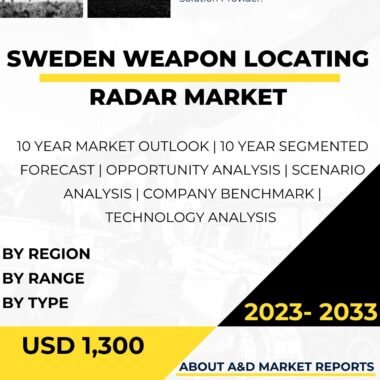Description
The South Korea weapon locating radar market is a critical and rapidly advancing segment of the country’s defense industry, providing advanced radar systems that play a pivotal role in detecting and locating enemy artillery and rocket launchers. Weapon locating radar systems are essential for modern militaries as they provide early warning and situational awareness, enabling timely responses to incoming threats and enhancing the survivability of friendly forces. South Korea’s focus on indigenous development, strategic partnerships, and technological innovation has positioned it as a notable player in the global weapon locating radar market.
Weapon locating radar systems are designed to detect and track the trajectory of incoming enemy projectiles, such as artillery shells and rockets. These radar systems use sophisticated algorithms and data processing to quickly calculate the location of the enemy firing positions, allowing friendly forces to respond with counter-fire or take evasive action.
Indigenous development has been a cornerstone of South Korea’s approach to the weapon locating radar market. The country’s defense industry, represented by companies like LIG Nex1 and Hanwha Systems, has made significant strides in developing advanced weapon locating radar systems tailored to meet the specific requirements of the South Korean military.
The South Korean military heavily relies on weapon locating radar systems to enhance its artillery countermeasure capabilities and protect its forces from enemy fire. These radar systems play a vital role in providing real-time information on enemy firing positions, enabling the rapid deployment of counter-fire assets to neutralize threats.
Beyond defense applications, weapon locating radar systems also have civilian uses in South Korea. Some technologies developed for military radar systems have been adapted for civilian applications, such as weather surveillance and air traffic control.
South Korea’s commitment to innovation and research and development (R&D) has driven significant advancements in weapon locating radar technology. The country invests in R&D programs to improve radar range, accuracy, and data fusion capabilities. Technological improvements focus on enhancing radar sensitivity, reducing false alarms, and improving resistance to electronic warfare and jamming.
Strategic partnerships with international defense and technology companies have also contributed to South Korea’s weapon locating radar capabilities. Collaborations enable technology transfer, joint research, and the integration of foreign radar systems into South Korea’s indigenous platforms, enriching the overall weapon locating radar capabilities of the country’s defense industry.
To ensure optimal utilization and proficiency in operating weapon locating radar systems, South Korea places significant emphasis on training and skill development for its military personnel. Training programs focus on familiarizing radar operators with system controls, data interpretation, and effective utilization in various operational scenarios.
Moreover, reliability and accuracy are paramount considerations in the weapon locating radar market, given the critical nature of these systems in protecting friendly forces and civilians from enemy fire. South Korea adheres to stringent radar maintenance standards and calibration procedures to ensure the reliability and performance of weapon locating radar systems, minimizing the risk of false alarms or missed detections.
In conclusion, the South Korea weapon locating radar market is a critical aspect of the country’s defense capabilities. Indigenous development, strategic partnerships, and innovation have allowed South Korea to create advanced weapon locating radar systems that meet the specific needs of its military and contribute to enhancing its artillery countermeasure capabilities. From providing early warning and situational awareness to enabling rapid responses to enemy threats, weapon locating radar systems play a pivotal role in strengthening South Korea’s military readiness and protecting its forces. As the defense industry continues to evolve, South Korea’s dedication to advancing its weapon locating radar technology will remain essential in maintaining its position as a major player in the global radar market.




